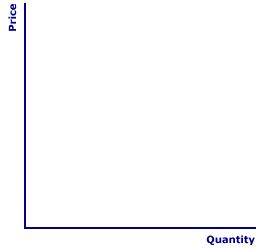
|
|
VOLUNTARY EXCHANGE: The process of willingly trading one item for another. The emphasis here is on "willingly." Voluntary exchanges are the heart and soul of market transactions, and should be contrasted with the "involuntary" exchanges mandated by government taxes, laws, and regulations. While involuntary government-forced exchanges play an important role in a mixed economy, economists really, really like voluntary market exchanges because they promote economic efficiency.
Visit the GLOSS*arama
|
|


|

|
                           ELASTICITY AND SUPPLY INTERCEPT: The intersection of a straight-line supply curve with vertical price axis and/or horizontal quantity axis reveals the relative price elasticity of supply. Intersection with the horizontal quantity axis means inelastic and intersection with the vertical price axis means elastic. Intersection with the origin means unit elastic supply. The positioning of a supply curve relative to the price and quantity axes indicates the price elasticity of supply. Unlike demand, a straight-line supply curve does not contain all five elasticity alternatives. However, the elastic or inelastic nature of a supply curve is revealed by the intersection with the vertical price axis and/or horizontal quantity axis.Five Elasticity Alternatives| Five Supply Curves |  |
The elasticity of a supply curve depends on whether the supply curve intersects the price axis, the quantity axis, or the origin. The exhibit to the right can be used to illustrate the five elasticity alternatives.- Perfectly Elastic: First up is perfectly elastic supply, which means an infinitesimally small change in price results in an infinitely large change in quantity supplied. The coefficient of elasticity for this alternative is E = ∞. A click of the [Perfectly E] button reveals a perfectly elastic supply curve, which is horizontal and intersects the vertical price axis.
- Relatively Elastic: Next up is relatively elastic supply, which means a relatively small change in price results in a relatively large change in quantity supplied. The coefficient of elasticity for this alternative is in the range of 1 < E < ∞. A click of the [Relatively E] button reveals a relatively elastic supply curve, which is flat but not horizontal and intersects the price axis.
- Unit Elastic: Third on the list is unit elastic supply, which means that any change in price is matched by an equal relative change in quantity. The coefficient of elasticity for this alternative is in the range of E = 1. A click of the [Unit Elastic] button reveals a unit elastic supply curve, which is a straight line extending from the origin.
- Relatively Inelastic: Next is relatively inelastic supply, which means a relatively large change in price is needed to induce a relatively small change in quantity supplied. The coefficient of elasticity for this alternative is in the range of 0 < E < 1. A click of the [Relatively In] button reveals a relatively inelastic supply curve, which is steep but not vertical and intersects the quantity axis.
- Perfectly Inelastic: Lastly is perfectly inelastic supply, means that quantity supplied is unaffected by any change in price. The coefficient of elasticity for this alternative is E = 0. A click of the [Perfectly In] button reveals a perfectly inelastic supply curve, which is vertical and intersects the horizontal quantity axis.
An Explanation, PleaseAn explanation of this connection between elasticity and intercept can be had with a closer look at the elasticity concept. Elasticity is comparison between the percentage changes in price and quantity. A percentage change depends on both amount of the change, or the unit change, and the starting point, or base value, of the change. Because slope is constant for a straight-line supply curve, unit changes are always proportional for any of the supply curves displayed here.The difference in elasticity rests with the base values. For a supply curve that intersects the vertical price axis, price starts with a larger base value than quantity. As such, any subsequent price change is relatively smaller, compared to this larger base, than the quantity change. This results in a relatively elastic supply. For a supply curve that intersects the horizontal quantity axis, quantity starts with a larger base value than the price. As such, any subsequent quantity change is relatively smaller, compared to this larger base, than the price change. This results in a relatively inelastic supply. For a supply curve that goes through the origin, price and quantity start with equal zero values, and equal bases. As such, all subsequent price and quantity changes are proportional. This results in a unit elastic supply.

Recommended Citation:ELASTICITY AND SUPPLY INTERCEPT, AmosWEB Encyclonomic WEB*pedia, http://www.AmosWEB.com, AmosWEB LLC, 2000-2025. [Accessed: June 30, 2025].
Check Out These Related Terms... | | |
Or For A Little Background... | | | | | | | | |
And For Further Study... | | | | | | |
Search Again?
Back to the WEB*pedia
|



|

|
|
Post WWI induced hyperinflation in German in the early 1900s raised prices by 726 million times from 1918 to 1923.
|

|
|
"I learned about the strength you can get from a close family life. I learned to keep going, even in bad times. I learned not to despair, even when my world was falling apart. I learned that there are no free lunches. And I learned the value of hard work. " -- Lee Iacocca
|

|
AV
Actual Value
|

|
|
Tell us what you think about AmosWEB. Like what you see? Have suggestions for improvements? Let us know. Click the User Feedback link.
User Feedback
|


|


